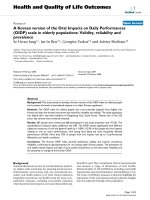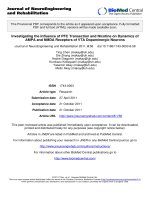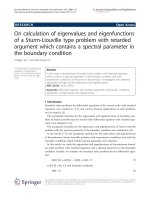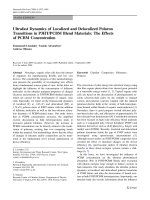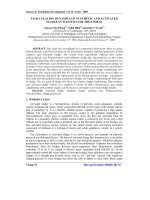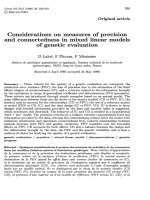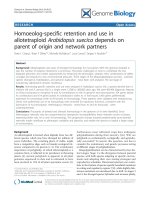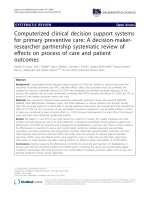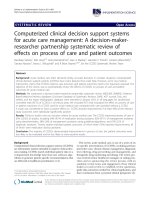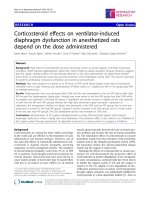Warming effects on dynamics of microbial communities in coastal waters of temperate and subtropical zones through dilution and fractionation experiments
Bạn đang xem bản rút gọn của tài liệu. Xem và tải ngay bản đầy đủ của tài liệu tại đây (2.3 MB, 76 trang )
THESIS
Warming effects on dynamics of microbial communities in
coastal waters of temperate and subtropical zones through
dilution and fractionation experiments
Dao Thi Anh Tuyet
Graduate School of Science and Technology, Educational Division
Department of Environment and Energy Systems
Shizuoka University
December 2014
THESIS
Warming effects on dynamics of microbial communities in
coastal waters of temperate and subtropical zones through
dilution and fractionation experiments
海水温上昇が温帯および亜熱帯の沿岸海洋微生物群集に与える影響
〜特にガンマプロテオバクテリアに注目して
Dao Thi Anh Tuyet
静岡大学
大学院自然科学系教育部
環境・エネルギーシステム専攻
2014 年 12 月
CONTENTS
Chapter 1
General introduction .......................................................................................... 1
Introduction .......................................................................................................... 1
Methodological approaches ................................................................................. 3
References for chapter 1 ...................................................................................... 6
Chapter 2
Effects of warming on microbial communities in coastal waters of
temperate and subtropical zones in Northern Hemisphere with a focus on
Gammaproteobacteria ..................................................................................... 10
2.1. Introduction ............................................................................................... 10
2.2. Materials and methods ............................................................................. 13
2.2.1. Study sites and sample collection ............................................................ 13
2.2.2. Experimental processing .......................................................................... 14
2.2.3. Total direct counts (TDCs) of prokaryotic abundance ............................... 15
2.2.4. Fluorescence in situ hybridization (FISH) ................................................. 15
2.2.5. Growth rates ............................................................................................. 16
2.2.6. Enumeration of protists ............................................................................ 17
2.2.7. Analysis of bacterial phylotypic community composition .......................... 17
2.3. Results ....................................................................................................... 20
2.3.1. Environmental parameters ....................................................................... 20
2.3.2. Warming effect on prokaryotes ................................................................. 21
2.3.3. Warming effect on bottom-up or top-down control by grazing .................. 22
2.3.4. Warming effects on Gammaproteobacteria .............................................. 24
2.4. Discussions ............................................................................................... 26
Acknowledgements ............................................................................................ 30
References for chapter 2 .................................................................................... 31
i
Figures chapter 2 ............................................................................................... 37
Table chapter 2 ................................................................................................... 43
Supplementary chapter 2 ................................................................................... 46
Chapter 3
Warming effect on the constituents of microbial communities ................... 49
3.1. Introduction ............................................................................................... 49
3.2. Materials and methods ............................................................................. 51
3.2.1. Sampling collection and experimental processing .................................... 51
3.2.2. Analysis of bacterial phylogenetic composition ........................................ 51
3.2.3. Nucleotide sequence accession numbers ................................................ 53
3.3. Results and discussion ............................................................................ 54
3.3.1. Constituents of the bacterial communities in Suruga Bay ......................... 54
3.3.2. Constituents of the bacterial community in Ha Long Bay .......................... 56
References for chapter 3 .................................................................................... 58
Figure chapter 3 ................................................................................................. 60
Conclusions and further works....................................................................... 69
Conclusions........................................................................................................ 69
Further works ..................................................................................................... 70
Acknowledgements.......................................................................................... 71
ii
Chapter 1
General introduction
Introduction
Climate change is recognized as one of the most serious environmental
concern for natural ecosystems and human activity. As a consequence of
climate change, sea temperature rose by 0.09 to 0.13 °C per decade over the
period from 1971 to 2010 (IPCC 2013). The consequence will be more serious
as climatic models predict that sea temperature will continue to increase with 24.8 °C during the 21st century (IPCC 2001, 2013). This warming may affect
different aspects of the function and structure of marine ecosystems (Edwards
and Richardson 2004, Montoya and Raffaelli 2010) particularly microbial food
web.
Among the marine environment, prokaryotes and viruses present as the
smallest constituents of ecosystem and to be considered to respond swiftly to
the environmental change such as temperature. Preceding studies indicated a
positive correlation between temperature and bacterial abundance (Write and
Coffin 1983, Lomas et al. 2002) or growth rate (White et al.1991, Shiah &
Ducklow 1994). However, controling mechanism of bacterial community through
warming as bottom-up or top-down control by grazer and viral infection in a given
community was not elucidated clearly. Sjöstedt et al. (2012) showed that a
bacterial community shifted its constituents responding to the changes in
temperature. To show some aspects of microbial food web under the effect of
warming, Sarmento et al. (2010) summarized related studies and indicated that
warming increases bacterial respiration and bacterial losses due to their grazers
and bacterial production if nutrients are available. These aspects of responses in
1
microbial production may affect fisheries by changing the microbial loop and
primary production which supply food resources for aquatic organisms such as
fish, crustacean, mollusk and so on.
Climate change provides many extreme climatic events which may influence
different aspects of ecosystem and environmental health. Another necessity of
microbial study related to environmental change stems from the fact that
microbial community includes pathogens which may bring problems to aquatic
organism and environmental health in coastal waters. A pioneering study by
Colwell (1996) clearly showed warming in surface temperature increased the
incidence of cholera in Bangladesh. A recent retrospective analysis suggested
that sea surface temperature warming is favoring the spread of vibrios (Vezzulli
et al. 2012, 2013) which has different response to environmental factors than
other heterotrophic bacterial population (Simidu et al. 1987).
Various studies have conducted until today on the warming effect on
microbes, however, most study sites belonged to temperate (Shiah and Ducklow
1994, Apple et al. 2006, Bouvy et al. 2011, Sjöstedt et al. 2012) or subarctic and
Arctic regions (Lara et al. 2013, Børsheim and Drinkwater 2014). Moreover, as
the strongest ocean warming is predicted for the surface layer in tropical and
subtropical regions of Northern Hemisphere (IPCC 2013), which might lead
different effect on microbes in subtropical water compared to that in temperate
zone.
Coastal area is regularly exposed to many anthropogenic influences such as
fishery or aquaculture activities, transportation, tourism, harbor and nutrients
supply. Two studied sites were selected in this study belonging to temperate
(Suruga Bay, Japan) and subtropical (Ha Long Bay, Viet Nam) coastal zones.
These two sites are completely different in climatic condition which may lead to
2
different responses of microbial communities against changing in temperature.
As microbial ecological studies had been conducted in Suruga Bay (Takenaka et
al. 2007; Hao et al. 2010) which provide sufficient information on the
environmental control of prokaryotes, present study aimed to reveal warming
effect on prokaryotes in this environment, which strengthen the understanding of
findings supported with previous data, and become a control study for
subtropical microbial ecology under the warming environment. Bottom-up and
top-down controls on prokaryotes under warming effect were also considered in
complex interactions of a given community (chapter 2).
As a response of potential pathogens to warming is considered to be major
concern, the present study focused on Gammaproteobacteria which include
various pathogenic bacteria (Brown and Volker 2004). In addition, bacterial 16S
rRNA gene was employed to evaluate how the constituents of microbial
community change in response to sea temperature rise (chapter 3) as an
important issue, which has not yet reported from previous study.
Methodological approaches
Microbes in coastal ecosystem are controlled by the availability of substrate
supply (bottom-up control) and the mortality caused by grazers and/ or viral
infections (top-down control). In order to elucidate the effect of warming on
microbial communities, dilution and size fractionation methods were very well
utilized (Landry and Hassett 1982, Wright and Coffin 1984, Rassoulzadegan and
Sheldon 1986, Šolić and Krstulović 1994, Yokohama et al. 2005). Top-down
control is regularly determined by two methods: 1) comparing the values
obtained with labeled bacteria as food tracers for natural assemblages as
described in Sherr et al. (1986), Wikner and Hagstrom (1988); 2) using size
3
fraction method to estimate the difference in bacterial number/ growth between
ungrazed (<1µm) and grazed (>1µm) as reported by Wright and Coffin (1984),
Coffin and Sharp (1987), Kuuppo-Leinikki (1990), Šolić and Krstulović (1994).
Though the fractionation method tends to give somewhat lower grazing impact
than the estimation from the experiment with labeled bacteria (Kuuppo-Leinikki
1990, Šolić and Krstulović 1994), the results of top-down control showed a
similar trend regardless of the method employed (Šolić and Krstulović 1994). In
present study, top-down control (by grazers) was estimated from difference in
bacterial number/ growth between ungrazed (<1µm) and grazed (>1µm)
samples as referred by Wright and Coffin (1984), Coffin and Sharp (1987), Šolić
and Krstulović (1994).
Similarly to top-down control, bottom-up control on prokaryote is estimated
from the differences in abundance and/ or growth rate of prokaryote between
control dilution samples. Dilution means sufficient nutrients as nitrogen and
phosphate involved in marine water are given to bacteria.
Small size fraction of sea water consists bacteria, their grazers and viruses.
Not only protozoa, but larger grazers such as copepods exist in the community.
However, the most important grazers of bacteria controlling bacterial abundance
was defined as small heterotrophic nanoflagellates/ grazer with theirs own size
less than 8 µm (Solic and Krstilovic 1994). Thus, in this study, pre-filtrate through
larger pore-size filters of 1 µm has not been conducted.
Observations from previous studies conducted in coastal water of Suruga
Bay and Ha Long Bay indicated that annual seawater temperature varied about
14.6-16.4oC (Takenaka et al. 2007, Hao et al. 2010) and 12oC (Faxneld et al.
2011), respectively. Otherwise, climatic models predict that sea temperature will
continue to increase with 2 - 4.8 °C during the 21st century (IPCC 2001, 2013).
4
Consequently, warming by 3 or 5°C has been conducted in different seasons to
estimate the impact of warming on microbial community in present study.
5
References for chapter 1
1. Apple JK, PA del Giorgi, WM Kemp (2006) Temperature regulation of bacterial
production, respiration, and growth efficiency in a temperate salt-marsh estuary.
Aquat Microb Ecol 43(3): 243-254
2. Børsheim KY, KF Drinkwater (2014) Different temperature adaptation in Arctic
and Atlantic heterotrophic bacteria in the Barents Sea Polar Front region.
Journal of Marine Systems 130:160-166
3. Bouvy M, Y Bettarel, C Bouvier, I Domaizon, S Jacquet, E Le Floc'h, H
Montanie, B Mostajir, T Sime-Ngando, JP Torreton, F Vidussi, T Bouvier (2011)
Trophic interactions between viruses, bacteria and nanoflagellates under various
nutrient conditions and simulated climate change. Environ Microbiol 13(7):1842–
1857
4. Brown JR, Volker C (2004) Phylogeny of gamma-proteobacteria: resolution of
one branch of the universal tree?. Bioessays 26(5):463–468
5. Coffin RB, JH Sharp (1987) Microbial trophodynamics in the Delaware estuary.
Mar Ecol Prog Ser 41:253-266
6. Colwell RR (1996) Global climate and infectious disease: the cholera
paradigm. Science 274:2025–2031
7. Edwards M, AJ Richardson (2004) Impact of climate change on marine
pelagic phenology and trophic mismatch. Nature 430: 881−884
8. Faxneld, S., Jörgensen, T.L., Nguyen, N.D., Nyström, M., Tedengren, M.
(2011) Differences in physiological response to increased seawater temperature
in nearshore and offshore corals in northern Vietnam. Marine Environmental
Research 71(3):225-233
9. Kuuppo-Leinikki P (1990) Protozoan grazing on planktonic bacteria and its
impact on bacterial production. Mar Ecol Prog Ser 63:227-238
6
10. Hao DM, T Tashiro, M Kato, R Sohrin, T Ishibashi, C Katsuyama, K Nagaosa,
H Kimura, TD Thanh, K. Kato (2010) Population dynamics of Crenarchaeota and
Euryarchaeota in the mixing front of river and marine waters. Microbes and
Environments 25(2):126–132
11. IPCC (2001) Climate Change 2001: The scientific basis. IPCC Third
Assessment Report, 2001. Contribution of Working group I to the third
assessment report of the Intergovernmental Panel on Climate Change
[Houghton JT, Y Ding, DJ Griggs, M Noguer, PJ van der Linden, D Xiaosu (eds)].
Cambridge University Press, Cambridge, United Kingdom
12. IPCC (2013) Summary for Policymakers. In: Climate Change 2013: The
Physical Science Basis. Contribution of Working Group I to the Fifth Assessment
Report of the Intergovernmental Panel on Climate Change [Stocker TF, D Qin,
G.-K. Plattner, M Tignor, SK Allen, J Boschung, A Nauels, Y Xia, V Bex and PM
Midgley (eds)]. Cambridge University Press, Cambridge, United Kingdom and
New York, NY, USA.
13. Landry MR, J Kirshtein, J Constantinou (1995) A refined dilution technique
for measuring the community grazing impact of microzooplankton, with
experimental tests in the central equatorial Pacific. Mar Ecol Prog Ser 120:53-63
14. Lara E, JM Arrieta, I Garcia-Zarandona, JA Boras, CM Duarte, SAgustí, PF
Wassmann, D Vaqué (2013) Experimental evaluation of the warming effect on
viral, bacterial and protistan communities in two contrasting Arctic systems.
Aquat Microb Ecol. 70:17–32
15. Lomas MW, P Glibert, F Shiah, EM Smith (2002) Microbial processes and
temperature in Chesapeake Bay: Current relationships and potential impacts of
regional warming. Global Change Biology 8:51-70
7
16. Montoya JM, D Raffaelli (2010) Climate change, biotic interactions and
ecosystem services. Phil Trans R Soc B 365:2013-2018
17. Rassoulzadegan F, RW Sheldon (1986) Predator-prey interactions of
nanozooplankton and bacteria in an oligotrophic marine environment. Limnol.
Oceanogr. 31:1010-1021
18. Sarmento H, JM Montoya, E Vázquez-Domínguez, D Vaqué, JM Gasol
(2010) Warming effects on marine microbial food web processes: how far can
we go when it comes to predictions?. Philos Trans R Soc Lond B Biol Sci
365(1549): 2137–2149
19. Sherr BF, EB Sherr, TL Andrew, RD Fallon, SY Newell (1986) Trophic
interactions between heterotrophic protozoa and bactenoplankton in estuarine
water analyzed with selective metabolic inhibitors. Mar Ecol Prog Ser 32:
169-180
20. Shiah F, HW Ducklow (1994) Temperature and substrate regulation of
bacterial abundance, production and specific growth rate in Chesapeake Bay,
USA. Mar Ecol Prog Ser 103:297-308
21. Simidu U, K Kogure, K Tsukamoto (1987) Distribution of Vibrionaceae in the
sea. Nihon Biseibutsu Seitai Gakkaiho 1:65-74
22. Sjöstedt J, Å Hagström, UL Zweifel (2012) Variation in cell volume and
community composition of bacteria in response to temperature. Aquatic
Microbial Ecology. 66(3): 237–246.
23. Šolić M, N Krstulović (1994) Role of predation in controllong bacterial and
heterotrophic nanoflagellate standing stocks in the coastal Adriatic Sea:
seasonal patterns. Mar Ecol Prog Ser 114:219-235
24. Takenaka T, T Tashiro, A Ozaki, H Takakubo, Y Yamamoto, T Maruyama, K
Nagaosa, H Kimura, K Kato (2007) Planktonic bacterial population dynamics
8
with environmental changes in coastal areas of Suruga Bay. Microbes and
Environments 22(3):257–267.
25. Vezzulli L, I Brettar, E Pezzati, PC Reid, RR Colwell, MG Hofle, C Pruzzo
(2012) Long-term effects of ocean warming on the prokaryotic community:
evidence from the Vibrios. ISME J 6(1):21–30
26. Vezzulli L, RR Colwell, C Pruzzo (2013) Ocean warming and pread of
pathogenic Vibrios in the aquatic environment. Microb Ecol 65:817–825
27. White PA, J Kalff, JB Rasmussen, JM Gasol (1991) The effect of temperature
and algal biomass on bacterial production and specific growth rate in freshwater
and marine habitats. Microb Ecol 21:99-118
28. Wikner J, A Hagstrom (1988) Evidence of a tightly coupled nanoplanktonic
predator-prey link regulating the bacterivores in the marine environment. Mar
Ecol Prog Ser 50: 137-145
29. Wright RT, Coffin RB (1983) Planktonic bacteria in estuaries and coastal
waters of northern Massachusetts: spatial and
temporal distribution. Mar Ecol
Prog Ser 11:205-216
30. Wright RT, RB Coffin (1984) Measuring microzooplankton grazing on
planktonic marine bacteria by its impact on bacterial production. Microb Ecol 10:
137-149.
31. Yokokawa T, T Nagata (2005) Growth and grazing mortality rates of
phylogenetic groups of bacterioplankton in coastal marine environments. Appl
Environ Microbiol 71(11):6799–6807
9
Chapter 2
Effects of warming on microbial communities in coastal waters of
temperate and subtropical zones in Northern Hemisphere with a focus on
Gammaproteobacteria
2.1. Introduction
Environmental warming alters food-web structures and ecosystem
functions (Petchey et al. 1999). Burrows et al. (2011) suggested that during the
last 50 years of thermal variations, the rate of shift of ecosystem constituents
was faster in the oceans than on land at some latitudes (in sub-Arctic zones and
within 15o of the equator) and that changes in seasonal timing were generally
greater in the ocean owing to smaller seasonal thermal variations compared to
these variations on land. In addition to these global implications, phenomena
that occur within individual ecosystems caused by climate change need to be
more thoroughly studied to understand the possible impacts of global warming.
Among the constituents of a coastal ecosystem, microbes are
considered to respond quickly to changes in temperature because of their small
cell sizes (i.e. large surface/volume ratios) and potentially rapid growth rates.
Daufresne et al. (2009) showed that the proportion of small-sized species in a
given population increased as a result of global warming by meta-analysis of
data obtained from long-term surveys and experimental analyses. Other studies
indicated a positive correlation between temperature and bacterial abundance
(Write and Coffin 1983, Lomas et al. 2002) and growth rate (White et al. 1991,
Shiah & Ducklow 1994). However, effect of temperature on the physiology of
microbes does not simply explain the effect of environmental warming on the
10
microbial community. Elucidating whether “top-down” (mortality) or “bottom-up”
(increased rate of production) control strongly affects the microbial community is
an approach to understanding the mechanism of the effect of warming on the
organisms. Several studies have been conducted with this approach. Šolić et al.
(2009) found that, under in situ conditions, bottom-up control dominated during
colder period whereas top-down control dominated during warmer periods.
Sjöstedt et al. (2012) showed that a microbial community shifted its composition
in response to changes in temperature. Although the evidence obtained from
controlled experiments and observations is not always consistent, Sarmento et
al. (2010) summarized related studies and indicated that warming increases
bacterial respiration and bacterial losses due to their grazers, and increases
bacterial production if nutrients are available. These aspects of responses of
microbial production and the resulting carbon flux may affect higher trophic
levels including fishery resources. Fish culture is an important component of
fisheries and is conducted in coastal environments. Thus we focus on coastal
environments in the present study.
With regard to bacteria, the effects of global warming on the distribution
and growth of pathogens must be particularly emphasized. A pioneering study by
Colwell (1996) showed clearly that a three-degree increase in surface
temperature increased the incidence of cholera in Bangladesh. A recent
retrospective analysis suggested that sea surface temperature warming is
favoring the spread of vibrios (Vezzulli et al. 2012, 2013). Because the response
of potential pathogens to warming is a major concern, we focused on
Gammaproteobacteria which include various pathogenic bacteria (Brown and
Volker 2004). To elucidate effect of warming on the prokaryotic community, we
selected two study sites, Suruga Bay in Japan and Ha Long Bay in Viet Nam,
11
being located in a temperate and a subtropical zone, respectively. Warming
effect on microbes in subtropical coastal water is not yet well elucidated. And
both sites are important areas of fishery and fish culture. In previous work
conducted in Suruga Bay, the abundance of Bacteria correlated positively with
temperature (p<0.05) (Takenaka et al. 2007). However, whether warming affects
the growth rate of a given prokaryotic community, Gammaproteobacteria in
particular, or the mechanism which determines the effect of warming have not
been elucidated. In this study, therefore, we designed an experiment to evaluate
whether top-down or bottom-up control strongly regulated the effect of warming
on these microbial communities.
12
2.2. Materials and methods
2.2.1. Study sites and sample collection
Water was sampled at the center of Shimizu Port, approximately 1.5 km
from the estuary of Tomoe River in Suruga Bay, Japan (35°00′56′′N–
138°30′58′′E) and near the three mouths of Troi, Man and Dien Vong Rivers in
Ha Long Bay, Viet Nam (20°55′17′′N–107°05′20′′E) where the water column
depths were 26.1 m and 4 m, respectively (Fig. 1). The studied sites were
expected to be affected by fresh water supply and anthropogenic activities in
surrounding urban area. Water samples were collected at a depth of 1 m using a
10-L Niskin water sampler (5026-D, Rigosha, Tokyo, Japan) as the surface water
was expected to be affected directly by climate change such as temperature,
sunshine and precipitation. Sampling was conducted seasonally on August 3,
2011 (summer), April 17, 2012 (spring), October 26, 2012 (autumn), and
February 11, 2013 (winter) in Suruga Bay and twice on August 8, 2012 (summer,
rainy season) and April 6, 2013 (spring, dry season) in Ha Long Bay.
Water temperature, pH, salinity and dissolved oxygen (DO), were
measured and recorded directly at the sampling sites using water quality
checkers (U-52, Horiba, Kyoto, Japan; WQC-24, DKK-TOA, Tokyo, Japan;
DO-HQ30d, Hach, Colorado, USA).
The concentrations of chlorophyll a and nutrients (NH4+, NO2−, NO3−, and
PO43−) were analyzed in the laboratory using fluorescence spectrophotometers
(RF-5300, Shimadzu, Kyoto, Japan and The Trilogy® Laboratory Fluorometer,
Turner Designs, USA), and a nutrient analyzer (TrAAcs 2000, Bran+Luebbe,
Nordersted, Germany), after Takenaka et al. (2007) and Hao et al. (2010). DOC
was analyzed using a total organic carbon analyzer (TOC-VCSH, Shimadzu).
Samples were immediately placed into sterilized 250-mL and 500-mL
13
Pyrex bottles (Barloworld Scientific Ltd., Staffordshire, UK) for environmental
and microbial analysis, and for incubation experiments. All the samples were
then transported to the laboratory in less than 2 h on ice.
2.2.2. Experimental processing
Size fractionation was performed on the basis of an assumption that
prokaryotic size was usually >0.2 µm and protists were mostly trapped by
filtration with a 1.0-µm filter. Seawater was passed through 1.0 and 0.2-µm
Nuclepore filters (Whatman, Cambridge, UK) that retained 84.5% and 1.5% of
prokaryotes represented in the initial seawater (defined as 100% of prokaryotic
abundance), respectively when we examined seawater collected from Suruga
Bay on November 4, 2013.
A set of experiments was performed in three different sterilized 500-mL
Duran (Mainz, Germany) bottles, with duplicates for each experiment. Each
bottle was filled with 500 mL of seawater. The first was a natural community
(control), the second (protist-free) was a filtrate from a 1.0-µm Nuclepore filter
(Whatman), and the third (dilution) was approximately equal volumes of
non-filtered seawater and filtered seawater passed through a 0.2-µm
Nuclepore filter (Whatman). Top-down control by grazing was estimated from
the different abundance of prokaryotes in the control and protist-free samples.
Bottom-up control was estimated from the difference abundance of
prokaryotes in control and dilution samples (Supplementary Fig. S1). The
dilution factor was defined as a ratio of prokaryotic abundance in the control
sample to that in the dilution sample.
The experiments were started after less than 30 minutes adjusting of
temperature for each experimental condition. Each experiment was set up in
incubators (Unit water bath Thermominder SD, TAITEC, Saitama, Japan) set at
14
different temperatures: in situ temperature (the temperature of the sampling site)
and temperature 3 or 5 degrees higher than the in situ temperature. The
incubations were conducted near the sampling sites under the natural light
condictions.
2.2.3. Total direct counts (TDCs) of prokaryotic abundance
Prokaryotic abundance (TDC) was determined initially, then after 3 (or 4),
6, 12 (or 15), and 24 (or 20) h during incubation experiments, in accordance with
the methods of Porter and Feig (1980). A sub-sample was fixed with neutralized
formaldehyde (Wako, Osaka, Japan; final concentration 2%, pH 7.4), collected
on a black 0.2-µm Nuclepore filter (Whatman), and then stained with 4′,
6-diamidino-2-phenylindole
(DAPI; Nacalai Tesque, Kyoto, Japan;
final
concentration 0.01µg mL−1). Samples were directly quantified under an
epifluorescence microscope (BX51-FLA, Olympus, Tokyo, Japan; Ultraviolet
excitation filter U-MWU2) by using 20 microscopic fields which contained more
than 400 cells for each sample.
2.2.4. Fluorescence in situ hybridization (FISH)
We used rRNA-targeted oligonucleotide probes specific for Bacteria
(EUB338) (Amann et al. 1990) and Gammaproteobacteria (GAM42a) (Manz et
al. 1992). These probes were commercially synthesized and labeled with
fluorescein isothiocyanate (FITC). An unlabeled probe cGAM42a was used as a
competitor for GAM42a because of one base pair mismatch between these
probes (Manz et al. 1992) (Table 1). Planktonic abundance of Bacteria and
Gammaproteobacteria was assessed using the method described by Takenaka
et al. (2007). The samples were fixed with paraformaldehyde (final concentration
3%, pH 7.2) and kept at 4°C for up to 24 h. The fixed samples were then filtered
through a 0.2-µm Nuclepore filter (Whatman). The microbial cells trapped on the
15
filter were rinsed three times with filtered phosphate-buffered saline (Dulbecco’s
PBS(−); Nissui ,Tokyo, Japan; pH 7.2) and dehydrated with 1 mL of 50%, 80%
and 99.5% ethanol for 3 minutes each, then dried at room temperature and
stored at –20°C until hybridization. Hybridization were performed at 46°C for 90
minutes on filters placed on slides coated with gelatin, hybridization buffer (0.9 M
NaCl, 20 mM Tris-HCl [pH 7.4], 0.01% SDS, formamide [20% for EUB338, 35%
for GAM42a]) and 5 ng µL−1 of the respective labeled probe. Each filter was then
washed at 48°C for 15 minutes in pre-warmed washing buffer (NaCl [0.225 M for
EUB338, 0.080 M for GAM42a], 20 mM Tris-HCl [pH 7.4], 5 mM EDTA, 0.01%
SDS), then rinsed with MilliQ water and air-dried. The filter was stained with 0.1
µg mL−1 DAPI on glass slide, for 5 minutes. The abundance of Bacteria and
Gammaproteobacteria were estimated as the ratio of hybridized cells to
DAPI-stained cells on the basic of pictures taken by use of a universal
epifluorescence microscopic system (BX51-FLA, Olympus) equipped with a
digital camera (DP71, Olympus; Ultraviolet excitation filter U-MWU2 and blue
excitation filter U-MNIB3). Twenty microscopic fields were examined for each
sample with approximately 300-1,400 DAPI-positive cells. The number of
FITC-positive cells varied, depending upon the relative contribution of each
subgroup, and ranged from 30-700 cells for each sample.
2.2.5. Growth rates
Prokaryote growth rate (µ, h−1) for each treatment was determined from
the increase in the numbers of prokaryotes in each treatment sample, assuming
an exponential model as follows (Landry and Hassett 1982):
1
t
ln
Nt
No
Where t is incubation time (h), No and Nt are the prokaryote abundances
16
(cells mL−1) initially and after incubation for t h, respectively.
2.2.6. Enumeration of protists
The abundance of protists was determined for samples taken from
coastal water by modifying the method of Lim et al. (1993, 1996). Samples were
fixed with neutralized formaldehyde (Wako; final concentration 3.7%) and filtered
through 1.0-µm Nuclepore filters (Whatman) within 48 h. The cells trapped on
the filter were dehydrated and dried at room temperature.
Pre-hybridization was performed at 40°C for 45 minutes with 5 × SET
buffer (0.75 M NaCl, 100 mM Tris–HCl [pH 7.8], 5 mM EDTA, 0.1%SDS). The
three labeled probes EUK 309 (Sogin and Gunderson 1987), EUK 1209
(Giovannoni et al. 1988), and EUK 502 (Amann et al. 1990) (Table 1) were
added to each filter (final concentration 0.5 ng µL −1 respectively). Hybridization
was performed at 40°C for 180 minutes; samples were then washed at 45°C for
10 minutes in pre-warmed 0.2 × SET buffer (30 mM NaCl, 4 mM Tris-HCl [pH
7.8], 0.2 mM EDTA). The filters were air-dried and then stained with 0.1 µg mL−1
DAPI.
The
numbers
of
protists
were
quantified
directly
under
an
epifluorescence microscope (BX51-FLA, Olympus; Ultraviolet excitation filter
U-MWU2 and blue excitation filter U-MNIB3). Each sample was examined in 20
microscopic fields, for duplicate filters of each sample; Total number of cells was
approximately 50-450.
2.2.7. Analysis of bacterial phylotypic community composition
DNA collection and extraction
DNA samples were obtained at the sampling sites and on completion of
the experiments. Different volumes of seawater (0.5 to 2 L) were passed through
17
0.22-µm Sterivex–GV filter unit (Millipore, Massachusetts, USA), and DNA from
trapped organisms was extracted in accordance with the method described by
Somerville et al. (1989). Cells were lysed in the filter unit with lysozyme and
proteinase K. Bulk DNA was extracted with a 25:24:1 (v/v) phenol–chloroform–
isoamyl alcohol at pH 8.0, then concentrated by ethanol precipitation. The
nucleic acid pellet was suspended in 30 μL of TE buffer (10 mM Tris-HCl, 0.1mM
EDTA, pH 8.0).
Cloning and sequencing of bacterial 16S rRNA gene fragments
Extracted DNA was amplified by polymerase chain reaction (PCR), by
using
KOD-Plus
DNA polymerase
(Toyobo,
Osaka,
Japan)
and
the
bacteria-specific primer set 27F (5′-AGAGTTTGATCMTGGCTCAG-3′) and
Uni1492R (5′-GGY TACCTTGTTACGACTT-3′) (Lane 1991). PCR products were
cloned by use of the Zero Blunt TOPO PCR Cloning Kit (Invitrogen, Paisley, UK).
Clone libraries of bacterial 16S rRNA gene fragments of each sample were
constructed separately. Specific patterns of DNA fragments of different sizes
were digested with restriction endonuclease MspI (Takara Bio, Shiga, Japan).
The sequences of the inserted PCR amplicons from selected recombinant
colonies were analyzed by use of a capillary DNA sequencer (CEQ2000XL DNA
Analysis System; Beckman Coulter, California, USA) with a bacterial specific
primer (27F). Approximately 550 nucleotide lengths were analyzed.
Bacterial phylogenetic analysis
Sequences were checked for chimeric artifacts by use of Check-Chimera
program
( />
Nonartifact
sequences were classified into high-order taxonomic units by Classifier,
Ribosomal
Database
Project
II,
RDP
( />
classifier.jsp) on the basis of 16S rRNA sequences (Wang et al. 2007).
18
Sequences were aligned by use of the CLUSTAL W package in the DNA Data
Bank of Japan (DDBJ) (Thompson et al. 1994). Clones with homology values
>80% and >97% were classified into phylogenetic groups and operational
taxonomic units (OTUs), respectively (Schloss and Handelsman 2005). The
closest related sequences to 16S rRNA gene were searched for by using the
Basic Local Alignment Search Tool (BLAST, (Altschul
et al. 1997).
19
2.3. Results
2.3.1. Environmental parameters
The measured physicochemical parameters at depths of 1 m are
summarized in Table 2. The temperature of the water examined in Suruga Bay
ranged from 12.1°C to 25.6°C, which was within the temperature ranges
observed in previous studies (Takenaka et al. 2007, Hao et al. 2010).
In contrast with the temperate coastal environment, the temperature of
the examined water of Ha Long Bay, located in a subtropical zone, was 29.9°C in
August 2012 and 22.7°C in April 2013.
Nitrate and phosphate concentrations in the water from Suruga Bay
ranged from 0.88 to 14.85 µmol L−1 and from 0.07 to 0.88 µmol L−1, respectively.
These values did not differ from previous observations (Takenaka et al. 2007;
Hao et al. 2010).
Nitrate and phosphate concentrations in the water obtained from Ha Long
bay in August 2012 were 2.52 µmol L−1 and 0.20 µmol L−1, respectively.
DOC concentration was less than 100 µmol L−1 for the two water samples
examined in Suruga Bay, whereas it was five times higher in the water samples
examined in Ha Long Bay in August 2012. This very high concentration of DOC
might be caused from the particles transported by fresh water as it was rainy
season in Viet Nam.
Chlorophyll a concentration in Suruga Bay ranged from 11.74 to 25.70 mg
m−3, except for winter. Chlorophyll a concentration in Ha Long Bay was 2.47 and
12.87 mg m−3. Dissolved oxygen (DO) concentrations and pH in Suruga Bay
ranged from 9.38 to 12.66 mg O2 L−1 and from 7.59 to 8.38, respectively. These
values did not differ for the two observations made in Ha Long Bay (DO: 8.11 to
8.19 mg O2 L−1 and pH: 8.01 to 8.19). Salinity in Suruga Bay ranged from 27.0‰
20
